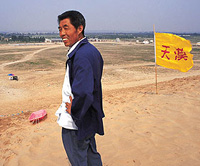 Human activities have driven the desert in north China southward by approximately 300 kilometers over the past 3,000 years.
Human activities have driven the desert in north China southward by approximately 300 kilometers over the past 3,000 years.
This was the conclusion of a team of scientists from the Earth Environment Research Institute under the Chinese Academy of Sciences (CAS), the University of Western Australia and the US University of Arizona.
However, from a mass of data on environmental changes from ancient times to the present affecting the desert-loess transition zone near the big bend of the Yellow River in north China, the scientists also held that greater rainfall from changes in the East Asia monsoon pattern currently affecting the semi-arid to arid areas in this region was likely to help prevent and reverse desertification.
On the basis of their research findings between 1999 and 2001, the scientists from China, Australia and the United States found that human activities have accelerated the desertification process in this area. Their findings were published in the science magazine Holocene 12 in 2002.
Over more than 3,000 years, a growing population, incessant agricultural activities, excessive tree-felling and frequent warfare had damaged the natural vegetation, causing soil erosion and intensifying desertification in this area, said Dr. Zhou Weijian, chief scientist of the State Key Laboratory of Loess and Quaternary Period Geology under the CAS.
However, an ongoing active monsoon climate brought 200-400 mm of rainfall to the area annually, good conditions for preventing and reversing desertification, he said.
The scientists focused on two periods -- the last glacial maximum period, dating back 13,000 to 21,000 years, and the Holocene precipitation optimum period, dating back 5,000 to 10,000 years. With the use of geological evidence, analysis of the environmental index and a detailed chronological framework, the scientists were able to "restore" the original environment during the chosen periods and evaluate desert margin position changes.
In China, Zhou said, precipitation was related to the position of the summer monsoon. During the last glacial maximum period, the continental monsoon was very weak, and dry weather caused the desert margin on the Ordos Highlands and monsoon front to shift southward. At the same time, the Hobq and Muus Deserts merged and the area of desert increased significantly, Zhou noted.
But during the Holocene precipitation optimum period, the summer monsoon was heavy and the desert margin and the monsoon front shifted northward. The Muus sandy land was then characterized by grassland, according to Zhou.
At present, China's mainland area was still controlled by an active monsoon climate, and the monsoon front remained at the same latitude. Nevertheless, the desert margin lay three degrees southward, the same position as during the last glacial maximum period, Zhou said. The environment index, historical records and archaeological discoveries all prove that human activities over the past 3,000 years were to blame for the southward movement of the desert margins in the research area, the scientists noted.
Archaeological discoveries show that the ruins of the Microlithic and Yangshao cultures, dating back more than 4,000 years, are densely distributed in the area between 38 degrees and 41 degrees north latitude, indicating the area was typically grassland at that time. The traces of ensuing human activities were closer to the Yellow River.
Most of the ruins of ancient houses and other building structures unearthed today are located in present-day desert, archaeological materials show. Built in the early 5th century, Tongwan city, the capital of the Western Xia Dynasty (1038-1227), is now buried in the Muus Desert. When it was first built, the area around the city was fertile farmland and the city had sufficient fresh water, according to historical material.
(Xinhua News Agency October 23, 2002)
|

